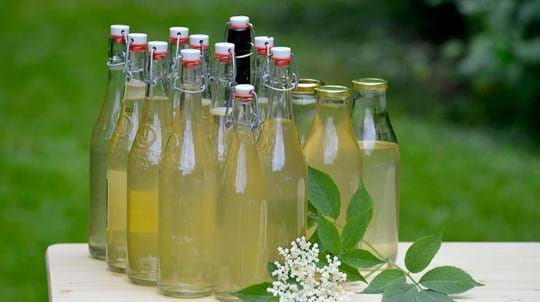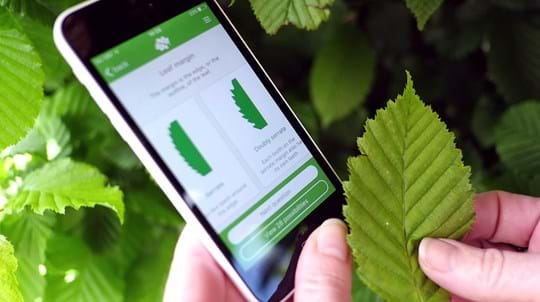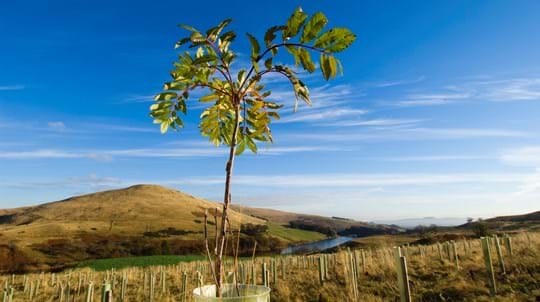
Credit: Alan Belton / WTML
Leaves
Pinnate (resembling a feather), with 5–7 oval and toothed leaflets which smell unpleasant when touched or bruised.
Feared by the devil. Favoured by foragers. Elder is the very essence of summer with its fragrant flowers and soot-dark fruits. It was said that an elder planted by your house would keep the devil away.
Common name: elder
Scientific name: Sambucus nigra
Family: Adoxaceae
Origin: native
Mature elder trees grow to a height of around 15m and can live for 60 years. Elder is characterised by its short trunk (bole), and grey-brown, corky, furrowed bark. It has relatively few branches.
Look out for: leaves which have 5–7 pairs of leaflets with sparsely serrated edges.
Identified in winter by: the green, unpleasant-smelling twigs which are hollow or have a white pith (spongy tissue) inside. Buds have a ragged appearance, often with leaves showing through the bud scales.

Credit: Alan Belton / WTML
Pinnate (resembling a feather), with 5–7 oval and toothed leaflets which smell unpleasant when touched or bruised.

Credit: Alan Belton / WTML
Borne on large, flat umbels, 10–30cm across, the individual flowers are creamy-coloured, highly scented, and have five petals. Flowers generally appear from late May.

Credit: Ben Lee / WTML
After pollination by insects, each flower develops into a small, purple-black, sour berry, which ripens from late-summer to autumn. Elders are hermaphrodite, meaning both the male and female reproductive parts are contained within the same flower.
Walnut (Juglans regia). Elder has oppositely arranged leaves whereas walnut has alternately arranged leaves.

Have you noticed buds bursting into leaf or fruit ripening in the hedgerows? Tell us what's happening to the trees around you and help scientists track the effects of climate change on wildlife.
Take part in our Nature's Calendar surveyElder is widespread in many temperate and subtropical regions of the world. It’s widespread across the UK, growing in woodland, scrub, wasteland and along hedgerows.
It’s often found near rabbit warrens or badger setts, where the animals distribute the seed via their droppings.
The flowers provide nectar for a variety of insects and the berries are eaten by birds and mammals. Small mammals, such as dormice and bank voles, eat both the berries and the flowers.
Many moth caterpillars feed on elder foliage, including the white-spotted pug, swallowtail, dot moth and buff ermine.
It was thought that if you burned elder wood you would see the Devil, but if you planted elder by your house it would keep the Devil away. It is also known as the ‘Judas tree’ as Judas Iscariot is said to have hanged himself from an elder tree.
It is thought the name elder comes from the Anglo-Saxon 'aeld', meaning fire, because the hollow stems were used as bellows to blow air into the centre of a fire.
Elder wood is hard and yellow-white. Mature wood is good for whittling and carving, while smaller stems can be hollowed out to make craft items.
Elder foliage was once used to keep flies away and branches were often hung around dairies.
Although the flowers and cooked berries (pulp and skin) are edible, the uncooked berries and other parts of plants from the genus Sambucus are poisonous.
The flowers are often used to make wine, cordial or tea, or fried to make fritters. The vitamin C-rich berries are often used to make preserves and wine, and can be baked in a pie with blackberries.
Elder is also a great source for a variety of coloured dyes and historically it was used to make lushly patterned Harris Tweed. Blue and purple dye was obtained from the berries, yellow and green from the leaves, and grey and black dye was made from the bark.
Elder is a popular small tree for gardens, and many cultivated varieties exist with different coloured foliage and flowers.
Elder may be susceptible to black fly and the sap-sucking red spider mite.

Blog
Helen Keating • 07 Jun 2021

Trees woods and wildlife
Use our free Tree ID app for Android and iPhone to identify the UK's native and non-native trees.

Shop
We have single trees and tree packs to meet your needs, from wildlife to woodfuel. Delivery is free.
External link